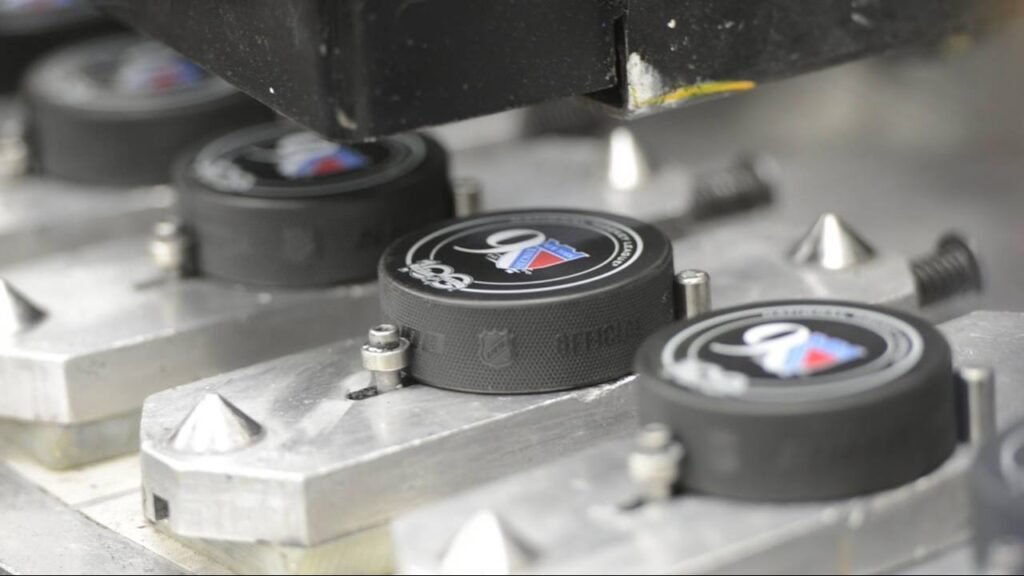This small, disk-shaped object is not merely a tool of the game but a symbol of sheer force and agility. As players maneuver across the icy surface, they aim to propel the puck into the opponent’s net with unparalleled speed and accuracy.
A puck in ice hockey can reach astonishing speeds, with professional players often propelling it at velocities exceeding 100 miles per hour (160 kilometers per hour).
Feel the rush as we dive into the exhilarating world of ice hockey, where the puck becomes a blur of velocity and power!
Understanding The Dynamics Of Puck – Here To Know!
At the core of the puck’s velocity lies the principles of physics, where forces such as acceleration, friction, and momentum intertwine to create a spectacle of motion. Here’s a glimpse into the scientific marvel behind the puck’s lightning-fast journey:
- Acceleration: When players strike the puck with their stick, they impart a force that accelerates it forward. The puck’s initial velocity, combined with the force applied, determines its rate of acceleration.
- Friction: As the puck glides across the ice, it encounters resistance in the form of friction. However, the low friction coefficient of ice allows the puck to maintain its speed with minimal resistance, enabling it to glide effortlessly across the rink.
- Momentum: The puck’s mass and velocity contribute to its momentum, a fundamental property of moving objects. By harnessing the principles of momentum transfer, players can unleash the full potential of the puck’s kinetic energy.
How Fast Can NHL Pucks Fly?- Let’s See!

NHL hockey pucks are built for speed, racing across the ice at astonishing velocities. These small rubber discs can fly at incredible speeds, often exceeding 100 miles per hour.
The combination of player skill, the puck’s design, and the ice’s slick surface allows them to reach such remarkable velocities.
Whether it’s a slapshot, wrist shot, or any other type, NHL pucks are known for their lightning-fast movement, adding an extra layer of excitement to the game as players strive to control and maneuver them precisely.
How Fast Is An NHL Wristshot? – Check It Out!
An NHL wrist shot is a swift and accurate maneuver, typically launched by players with precision and finesse. These shots can reach impressive speeds, averaging between 60 to 90 miles per hour.
What makes them particularly effective is their ability to surprise goaltenders with their quick release and pinpoint accuracy.
NHL players excel at mastering the mechanics of the wrist shot, using their stick-handling skills and body positioning to generate power and velocity.
Players employ a versatile technique to score goals and keep opposing teams on their toes, showcasing the talent and athleticism of professional hockey players.
Read: Is Astral Travel Dangerous? – Exploring Myth vs. Reality!
What Makes A Hockey Puck Travel Faster? – Let’s Explore!
Player Technique:
How a player handles the puck before taking a shot greatly influences its speed. Factors such as the angle of the blade and the spin applied to the puck can affect its velocity.
Players who can effectively control and manipulate the puck before releasing it can generate more power and momentum, resulting in a faster shot.
Stick Design and Properties:
The design and properties of the stick also play a significant role in the speed of the puck. A longer stick can provide more leverage, allowing players to generate greater force behind their shots.
Additionally, the flex of the stick, which refers to its ability to bend under pressure, impacts how efficiently energy is transferred to the puck. A stick with the right flex can store and release energy effectively, contributing to increased shot speed.
Puck Characteristics:

The physical properties of the puck itself, such as its weight and construction, impact how quickly it travels across the ice. A lighter puck may accelerate more rapidly, while a heavier puck may maintain its speed better over longer distances.
The material and design of the puck also influence its aerodynamics, affecting how smoothly it glides and how much resistance it encounters.
Ice Surface Condition:
The condition of the ice surface can also affect the speed of the puck. Smoother ice provides less friction, allowing the puck to glide freely and reach higher speeds.
Conversely, rough or uneven ice can slow the puck down and make it more difficult for players to control its trajectory. Factors like temperature and humidity can also influence ice conditions, further impacting puck speed.
Breaking Down The Speed Barrier – Professional Vs. Amateur!
Professional Players:
- In the fast-paced world of professional ice hockey, players exhibit unparalleled skill and precision, propelling the puck at astonishing velocities.
- Top-tier professionals can achieve speeds exceeding 100 miles per hour (160 kilometers per hour) during powerful slap shots and wrist shots.
Amateur Players:
- While amateur players may not match the speeds of professionals, they can still showcase impressive velocity with practice and technique.
- During shots and passes, amateur players typically achieve puck speeds ranging from 50 to 80 miles per hour (80 to 130 kilometers per hour).
How Fast Is The Shot Of An Average Hockey Player? – Read It Now!

While amateur or recreational hockey players may not match the speeds of NHL professionals, they can still achieve impressive shot velocities.
On average, an amateur player’s wrist shot might range from 40 to 70 miles per hour, while a slapshot could reach speeds between 60 to 80 miles per hour.
However, these figures vary widely based on the player’s skill level, strength, and experience.
Players who hone their technique and build strength over time may gradually increase their shot speeds, showcasing the diverse range of abilities within the recreational hockey community.
Read: Do Mice Travel In Pairs – The World Of Mouse Social Behavior!
Frequently Asked Questions:
1. How fast can a professional hockey player shoot a puck?
During powerful shots, professional players can shoot the puck at speeds exceeding 100 miles per hour (160 kilometers per hour).
2. What factors affect the speed of the puck?
The speed of the puck is influenced by factors such as the shot’s force, the stick’s angle, and the ice’s surface friction.
3. How does the design of the stick impact puck velocity?
Sticks with a stiffer flex provide more power and can generate higher puck speeds, while the blade’s curve affects the shot’s trajectory.
4. Can the puck reach higher speeds on synthetic ice surfaces?
Synthetic ice surfaces typically have higher friction coefficients than natural ice, which can affect the puck’s speed and glide.
5. Do goaltenders react differently to shots at varying speeds?
Goaltenders must adjust their positioning and reflexes based on the speed of the incoming puck, with faster shots requiring quicker reaction times.
6. Is there a correlation between player strength and puck speed?
While strength can certainly impact shot power, technique, and skill are crucial in maximizing puck velocity.
7. How do radar guns measure puck speed?
Radar guns utilize Doppler radar technology to detect the puck’s velocity across the ice surface.
8. Are there any safety concerns associated with high puck speeds?
High puck speeds can pose safety risks to players, coaches, and spectators, emphasizing the importance of protective gear and safety protocols.
9. Can wind resistance affect the puck’s speed during outdoor games?
Wind resistance can influence the trajectory and speed of the puck during outdoor games, particularly in open-air stadiums.
10. Has technology influenced puck speed in modern ice hockey?
Advances in stick design, ice surface technology, and player training methods have all contributed to the evolution of puck speed in modern ice hockey.
11. What role do referees play in monitoring puck velocity during games?
Referees are tasked with ensuring fair play and safety on the ice, including monitoring the speed and trajectory of shots to enforce rules and regulations.
12. How do players improve their puck-handling skills to increase speed and accuracy?
Players can enhance their puck-handling abilities through drills, practice sessions, and coach feedback, focusing on stickhandling, passing, and shooting techniques.
Conclusion:
Hockey pucks are lightning-fast, thanks to skilled players and powerful shots. The speed adds excitement to the game, whether a wrist shot or a slapshot. Players of all levels can improve their game and keep the action thrilling by understanding how to make the puck go faster.
Read:




